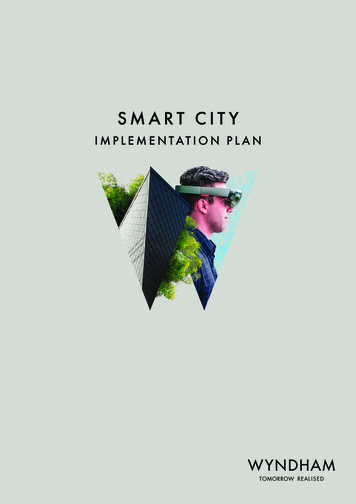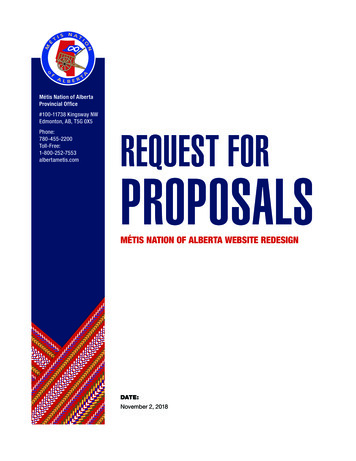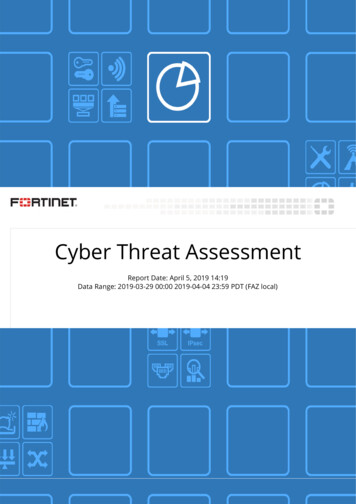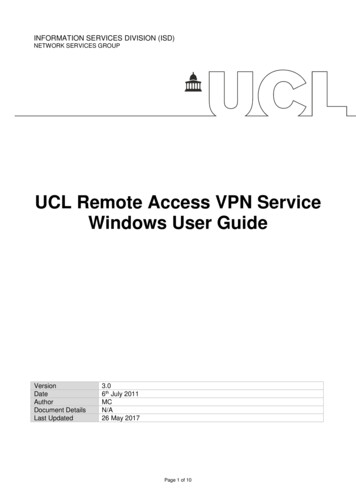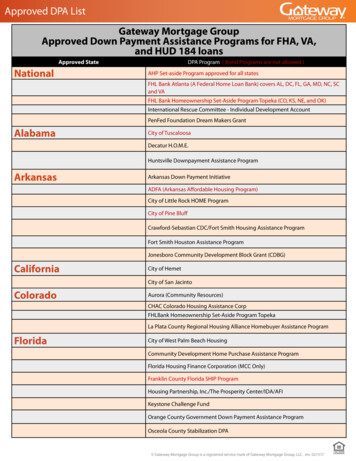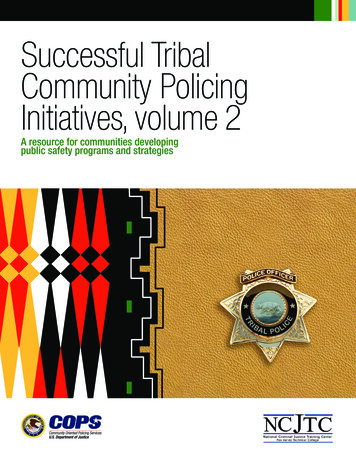
Transcription
Smart City Smart NationSmart City Smart NationClient stories in action0
Client storiesIsraelCity digital services index in IsraelDeloitte’s Smart City InitiativeAround the globe, cities are adaptingto technology in ways that bridgethe promise of the future with theunique character each has builtover the generations. While no twohave the same experience, many arelearning the same lesson: The pathahead is determined not by how manytechnologies are in use but by howwell they work together.The Deloitte 360 Smart CityFramework allows city stakeholdersto speak a common language as theydecide together how new tools canimprove the experience of city life.Across the domains of economy,mobility, security, education, living,and environment, Smart Cities expandthe definition of “infrastructure”and find new connections betweenold challenges.In each client story, and in themany more that will follow, peopleare finding a way to make theirenvironments healthier, greener, moreprosperous, and more responsive toresidents’ everyday needs. What canwe learn from their example?The proliferation of digital technologies has revolutionized government servicesacross the world. In many cases, digital services to residents and businesses was astarting point for many smart city initiatives across the globe. The Israeli government,recognizing the need for a comprehensive national digital policy back in 2013,1established the Digital Israel Bureau (within the Ministry for Social Equality) to accelerateeconomic growth, reduce socio-economic gaps, and make government services smarter,faster, and more accessible.2One of the key initiatives under theNational Digital Program was to build thefoundational architecture for a nationaldigital index. The index could help thestate of Israel measure progress againsteach of the three goals set by the NationalDigital Program. Such a measurement canalso help identify gaps and take necessarypolicy actions to drive progress in each area.The Digital Bureau along with the nationalICT Authority is currently developing thenational index and continues to refine it.3However, while the national digital index isintended to measure the efficacy of federalor national digital services, Israel still lackedan index that could measure digital servicesavailable locally. Hence, a local digital indexwas conceived to benchmark basic digitalservices at a decentralized level—across254 cities and municipalities.4 The drivingfactor for this initiative was the varying levelof digital maturity observed in differentmunicipalities. As cities continued theirmarch toward becoming truly smart, theyneeded to understand where they stood incomparison to their peers.5The local digital index project, called“digilocally,” started collecting data for all254 Israeli local authorities.6, 7The data wasgrouped into 25 indicators, each indicatorfurther classified under three categories—digital services for citizens, digital servicesfor businesses, and ease of accessibilityof these services. The digital services forcitizens indicators were given the mostweight of 60 percent, followed by 30 and 10percent to digital services for businessesand accessibility categories, respectively.8The purpose of the exercise was toexamine the digital services offered onwebsites of all the local authorities in Israel,including things such as how to registerkids in schools, how to pay for parking
Israeltickets, how to pay for utility bills, and howto apply for a business license. The ease ofaccessibility indicators focused on whetherthe websites had a search option, whetherthey were mobile-optimized and accessibleto the differently abled, and whether themunicipality had a mobile app.The digilocally index for municipalities waslaunched in January 2018 and was madeavailable through an open public microsite.It enables municipalities to compare theirrankings and explore categories and subcategories to identify areas where they havefared well or poorly. In addition to the selfassessment and benchmarking capabilities,the exercise also highlighted some interestinginsights. For instance, 96 percent of themunicipalities operated a website, 74 percentoperated Facebook pages, 51 percentfacilitated online kindergarten registrations,only 31 percent had a special dedicatedsection on their websites for businesses,28 percent supported online parking ticketpayment, and only 9 percent had an onlinequeue management system.9Tel Aviv and Jerusalem were among theleading municipalities in terms of theindex score. For instance, Jerusalem’shigh score was a reflection of its quality ofonline services in the areas of municipalproperty tax, payment of parking tickets andrequests for parking tags, contact optionsvia the website, access to resident files, andregistration to educational institutions. Themunicipality also enabled businesses toexplore information online regardingstarting a business, checking the statusof a business license, and applying for abusiness license.10How Deloitte helpedTo help Israel measure digital services locally—and to enable its cities to understandhow they compare to others—Deloitte partnered with the Interdisciplinary Center(IDC) Herzliya School of Government to launch Digilocally. With this local digital indexproject, Deloitte began benchmarking basic digital services at a decentralizedlevel—across 254 cities and municipalities. The data was grouped into 25 indicators,each indicator further classified under three categories: digital services for citizens,digital services for businesses, and ease of accessibility of these services.Digital services that were examined included how to register kids in schools, pay forparking tickets, pay for utility bills, and complete online business applications. Easeof accessibility indicators focused on whether the websites had a search option, weremobile-optimized, and were accessible to the differently abled. Another indicatorwas whether the municipality had a mobile app. The categories were then weighted60/30/10 percent for citizens, businesses and accessibility categories, respectively.Launched in January 2018, the Digilocally index for municipalities was made availablethrough an open public microsite. The municipalities can now compare theirrankings, explore categories and sub-categories where they have fared well orpoorly, and create a roadmap to improve digital services.The index serves as a benchmarking toolthat municipalities can use to comparetheir digital services. Many municipalitieshave used the index for improving digitalservices for their citizens. For instance, themunicipality of Ramat Hasharon, locatedin central Israel, with more than 46,000residents, used the index to lead the highestimprovement in its score, from 46 to 88. Thenational average has been 43.11In another example, the CIO for the city ofRaanana used the digital services index tocreate a unique personalized heat map thattakes the index a step further and maps alldigital services in the municipality as wellas areas that need improvement. Usingthe index as a starting point, the city built aContact us:Idan UrmanPartnerDeloitte Consulting LLPEmail: iurman@deloitte.co.ilNoa FellerSenior Strategy ConsultantDeloitte Consulting LLPEmail: nfeller@deloitte.co.ilworking plan to develop digital capabilitiesfurther. Raanana’s final score changed from80 to 87, which pushed the city into the top10 list in terms of the index score.12Since the launch, the index has been wellreceived by local governments and citizens.And there are plans for further expansion,which include adding more indicators toincrease its breadth and depth and todevelop a more robust scoring system.The version 2.0 of the index plans to includeplanning and construction services for bothcitizens and businesses, while the version 3.0plans to delve deeper into the internal digitalprocesses and infrastructure of the localauthorities and allow municipalitiesto assess the quality of service providedto citizens and businesses.Endnotes1.Ministry for social equality, “The Digital Israel National Initiative: The National Digital Program of theGovernment of Israel,” June, 2017.2. Headquarters for the National Digital Israel Initiative, Ministry of Social Equality, “About,” accessedDecember 14, 2018.3. Ministry for social equality, “The Digital Israel National Initiative: The National Digital Program of theGovernment of Israel,” June, 2017.4. Shally Tshuva, Smart cities—hype or reality?, Deloitte, accessed December 14, 2018.5. Ibid.6. Interview with Deloitte Israel team, November 5, 2018.7. Deloitte, “Deloitte’s digitally index,” accessed December 14, 2018.8. Deloitte Israel, “About the index,” accessed December 14, 2018.9. Tshuva, Smart cities—hype of reality?.10. Jerusalem Municipality, “Jerusalem tops Israel’s digital cities,” accessed December 14, 2018.11. Interview with Deloitte Israel team, December 10, 201812. Interview with Deloitte Israel team, December 10, 2018About DeloitteDeloitte refers to one or more of Deloitte Touche Tohmatsu Limited, a UK private company limited by guarantee (“DTTL”), its network of member firms, and their relatedentities. DTTL and each of its member firms are legally separate and independent entities. DTTL (also referred to as “Deloitte Global”) does not provide services to clients. Inthe United States, Deloitte refers to one or more of the US member firms of DTTL, their related entities that operate using the “Deloitte” name in the United States and theirrespective affiliates. Certain services may not be available to attest clients under the rules and regulations of public accounting. Please see www.deloitte.com/about to learnmore about our global network of member firms.Copyright 2019 Deloitte Development LLC. All rights reserved.
Client storiesSan DiegoHelping the city of San Diego “Get It Done”Deloitte’s Smart City InitiativeAround the globe, cities are adaptingto technology in ways that bridgethe promise of the future with theunique character each has builtover the generations. While no twohave the same experience, many arelearning the same lesson: The pathahead is determined not by howmany technologies are in use but byhow well they work together.The Deloitte 360 Smart CityFramework allows city stakeholdersto speak a common language asthey decide together how newtools can improve the experienceof city life. Across the domainsof economy, mobility, security,education, living, and environment,Smart Cities expand the definitionof “infrastructure” and find newconnections between old challenges.In each client story, and in themany more that will follow, peopleare finding a way to make theirenvironments healthier, greener,more prosperous, and moreresponsive to residents’ everydayneeds. What can we learn fromtheir example?With a population of around 1.4 milion, San Diego is the second largest city in thestate of California and eighth largest city in the United States.1 A city of this sizeshould ideally have a dedicated communication channel for residents to report nonemergency problems such as potholes, street light repair, illegal dumping, and graffiti(among others). However, unlike most major cities in the US, San Diego did not havea centralized process or system in place for residents to report these types for issuesuntil very recently.It started in 2015, when an audit reporthighlighted several developmentopportunities related to the City’s ability toengage with residents needing to reportnon-emergency issues. It concluded withthe recommendation of establishing acentralized customer service center andmobile application to report right-of-waymaintenance (ROW) issues such as potholes,illegal dumping, and damaged sidewalks.2This recommendation was further refinedafter a 2015 City of San Diego ResidentSurvey revealed that most residentspreferred digital means (website or mobileapp) to report issues, rather than makingphone calls.3In 2016, the lack of dedicated 311 systemnearly created a crisis in the city’s 911 callcenter because the sheer volume of callsmade it difficult for the 911 dispatchers todistinguish between life-threatening and nonpriority situations.4 In some cases, residentswere calling to report or to get updates onnon-emergency service requests becausethe City provided limited visibility into thestatus of these requests, due to a highlymanual and fragmented communicationprocess across city departments.The City’s administration realized that itneeded a system that could effectivelyaddress non-emergency issues in theCity, so in May 2016, San Diego piloteda Salesforce-based Get It Done app andcase management solution with theTransportation and Storm Water (TSW)department. Their objective was to come upwith a tech-driven, resident-focused solutionthat enables access to City non-emergencyservices and information anywhere,anytime, and on any device. After only afew months, the City was so encouragedby the results from the Pilot that theyfunded and launched a full-scale versionof the solution in July 2018, which includedkey departments like EnvironmentalServices Department (ESD), Development
San DiegoServices Department (DSD), Public UtilitiesDepartment (PUD), City Clerk, and more.With this expansion, the Get It Done - Digital311 solution has replaced five aging legacysystems and enabled a standardized andmore collaborative approach to manage andprocess service requests from residentsacross 8 departments.The Get It Done app has made lives easierfor both the City’s residents and its internalemployees. Before to its deployment,residents often did not know who to contactfor non-emergency issues. If they weresuccessful in reporting an issue, mostcommunications related to their issue washandled via internal emails and phone calls.In many cases, these emails ended up goingto the wrong department, which wouldthen require it to be rerouted to the correctdepartment by a City worker.5 As a result,information was lost in translation, and someof the requests never saw the light of theday. Now, residents can download the appor go to the website to upload photos of theproblem, enter a few details about the issue,and then submit their requests. The GISbased geo-tagging feature helps in creatinga user-friendly experience, while providingthe City with enough information to properlyroute and assign requests. The self-serviceweb portal allows residents to view theirservice requests on a map which includesinformation on the status and notes, allowingresidents to track their request from entry toresolution. The system also enables greatertransparency since a resident can view hercomplaint, regarding an open pothole, forinstance, along with other similar requestsin her area. Finally, the system has anestablished feedback mechanism that allowsresidents to rate their experience, as well asprovide specific feedback to the departmentresponsible for resolving the issue.How Deloitte helpedMultiple aging and disconnected IT systems left the City of San Diego with highlyfragmented and decentralized support processes that required manual communicationacross, and even within, departments. Residents wanting to report non-emergencyissues found it frustrating to determine which department to contact, and aftersubmitting a request, to not receive updates.After a successful pilot, Deloitte implemented the Salesforce cloud-based Get It DoneDigital 311 solution across departments using the Force.com platform. The Get ItDone application replaced five legacy systems, connecting nine key city departmentsand enabling true coordination and management of service request processing. Thesolution provides key capabilities including inter-departmental case management withautomated case routing, real-time status updates, external notifications and reminders,document generation, and key code-enforcement-related inspection features. Bycentralizing data across departments, Get It Done provides visibility into service requestmetrics and helps enable better decision-making.The application includes a self-service web portal and mobile application residentscan use to submit and check the status of service requests on any device, anywhere,anytime. The city can now interact better with its residents and provide real-timeupdates on service requests. Enabling new channels of communication reduced manualefforts, enabled 24/7 support, increased efficiency, and improved resident experience.The solution is designed to provideefficiencies through standardized casemanagement workflows, automatic caserouting, and enhanced interdepartmentalcommunications to support collaboration.The introduction of a mobile-friendly solutionalso means field workers can resolve alarger number of cases each day, rangingfrom cleaning graffiti to picking up dumpedgarbage, because the information theyneed is now available through their mobiledevices, instead of having to return to theiroffice to pick up paperwork. Additionally,their ability to group all open requests basedon the location has also helped improvedaily productivity by enabling workers tosee all open cases within a particular area.Finally, the integration of various city servicedepartments is helping the city build acentralized data repository, enabling betterdata-driven decision making. The city canEndnotes1.“Population”, Sandiego.gov, iego/population,accessed October 4, 2018.2.Roxanna Moradi, “Smarter CRM from a Customer Service Perspective: A Process Evaluation on the City ofSan José’s My San Jose Smartphone Application for City Services,” San Jose State University, 2018, referer &httpsredir 1&article 1591&context etd projects.3.ETC Institute, “2015 City of San Diego Resident Survey,” February 2016, cosd-resident-survey.pdf.4.Andrew Keatts, “A 311 Call Line Could Ease 911 Burden But City Might Not Implement It,” Voice of SanDiego, June 14, 2016, alks-at-implementing-it/.5.Interview with the Deloitte San Diego project team, September 2018.identify peaks and troughs related tocity services through the new system,thus allowing them to allocate theirresources efficiently.Looking forward, the City of San Diegoplans to expand the breadth and depthof the services offered throughGet It Done. Examples of proposedenhancements include: Providing residents with a user-friendlyprocess for requesting trash and recyclingcontainers, including the ability to pay forthem online. Including certain service requests for thePublic Utilities Department (PUD) Integrating data from IoT sensors aroundthe city to enable automated case creationand case validationContact us:Thomas BeyerPrincipalDeloitte Consulting LLPEmail: thbeyer@deloitte.comDavid LindstromManagerDeloitte Consulting LLPEmail: dlindstrom@deloitte.comAbout DeloitteDeloitte refers to one or more of Deloitte Touche Tohmatsu Limited, a UK private company limited by guarantee (“DTTL”), its networkof member firms, and their related entities. DTTL and each of its member firms are legally separate and independent entities. DTTL(also referred to as “Deloitte Global”) does not provide services to clients. In the United States, Deloitte refers to one or more of theUS member firms of DTTL, their related entities that operate using the “Deloitte” name in the United States and their respectiveaffiliates. Certain services may not be available to attest clients under the rules and regulations of public accounting. Please seewww.deloitte.com/about to learn more about our global network of member firms.Copyright 2018 Deloitte Development LLC. All rights reserved.James QuaSenior ManagerDeloitte Consulting LLPEmail: jqua@deloitte.com
Client storiesOrange CountyImproving “on-time” Public Works services in Orange CountyDeloitte’s Smart City InitiativeAround the globe, cities are adaptingto technology in ways that bridge thepromise of the future with the uniquecharacter each has built over thegenerations. While no two have thesame experience, many are learningthe same lesson: The path aheadis determined not by how manytechnologies are in use but by howwell they work together.The Deloitte 360 Smart CityFramework allows city stakeholdersto speak a common language asthey decide together how newtools can improve the experienceof city life. Across the domainsof economy, mobility, security,education, living, and environment,Smart Cities expand the definitionof “infrastructure” and find newconnections between old challenges.In each client story, and in themany more that will follow, peopleare finding a way to make theirenvironments healthier, greener,more prosperous, and moreresponsive to residents’ everydayneeds. What can we learn from theirexample?Orange County, California—with a population of more than 3 million—is the sixthmost populous county in the United States.1 The county is not only home to someof the largest Fortune 500 companies, colleges, and universities, but is also anattractive tourist destination, thanks to its sun-kissed beaches and the ever popularDisneyland. Covering an area of nearly 800 square miles2, day-to-day governanceof a county of this size comes with its own set of challenges, especially in terms ofdelivering infrastructure services.The Orange County Public WorksDepartment is responsible for a largenumber of services including flood channelmanagement, sidewalk maintenance, graffitiremoval, water pollution response, streetmaintenance including pothole repairs andtree and bee services.3 Like many otherpublic agencies, the department faced achallenge in efficiently deploying its limitedresources over this vast area of countyland and tracking and reporting on how thedepartment addresses the service requests.Until early 2017, residents who wanted toreport an issue to the department hadto register a service request via a call to ahelp desk telephone number or an emailafter completing an online form.4 Theservice requests that were received did notinclude the required geographic locationinformation. County staff would use multiplesources to conduct research then add thelocation information to the service requestprior to sending it to the inspection andmaintenance staff.Residents would be contacted by staffthroughout the lifecycle of the servicerequest; and residents had to call in if theywanted to check the status of a servicerequest. County staff would need to emailor call multiple staff members in orderto provide a status update to a resident.Duplicate service requests submitted bythe residents would further exasperate theissue.The department was aware that thisprocess was not an optimal use of thecounty’s limited resources and the levelof customer service could be improved.In April 2017, the department launched“myOC eServices”, which represented amajor step toward enhancing the levelof customer service residents receive.This new web and mobile-enabledportal not only streamlined the servicerequest process for residents, but alsomodernized the way the public worksdepartment addressed these requestsand managed its resources.
Orange CountyThe myOC eServices tool provides residentswith an easily accessible way to navigate cityservices. Residents visiting the online portalfirst select the service they require.The next steps involve pinpointing a locationon the map, uploading photos or files tosupport the request, adding comments, andfinally submitting the request. The servicerequest then flows to the appropriateservice area within the department witha standard priority where a central teamreviews and visualizes the request on aservice request map linked to the CountyGIS System along with other requests.This new visualization capability has allowedthe department managers to identifyprocess bottlenecks and organize resourcesto address pockets of high activity withinthe county. For instance, it can now indicatespecific areas where they are receiving alot of graffiti complaints from the residents.This enables the department managers tomake a data-based decision by assigningadditional inspection or maintenance staffto high-demand areas.In addition, field staff can now accessinformation on new complaints throughtheir mobile devices. Field staff can see theprecise location and quickly locate the issue.Updates can be made to the service requestfrom the field which allows residents toreceive real-time updates of their servicerequest. Also field staff are now able tomark a service request as “work completed”from the field on their mobile devices whichautomatically notifies the resident andinforms the department managers of thereason why the request is resolved. Theportal also instills a level of proactivity inthe department by allowing field and on-callstaff to enter new service requests duringtheir field inspections.How Deloitte helpedOrange County Public Works wanted to transform the way that they provideservices to and interact with their constituents. It wanted to modernize the waycitizen service requests were processed to speed up resolution and efficientlydeploy its limited resources over the large county. Systems were fragmentedand geographic location information was not always included in requests, andseveral units had no work order tracking system. The County turned to Deloitte,who responded by implementing its Citizen Connect- and Salesforce-basedCRM platform, which provides a flexible, scalable, and integrated solution forresponding to service requests.Deloitte’s cloud-based solution includes a Web- and mobile-enabled portaldesigned to benefit the County staff and the citizens alike. For the County staff,the solution streamlines the service request process and integrates with theCounty’s ESRI GIS to provide a single source of geographic truth. It integrates withlegacy work order management and provides task tracking for departments thatdo not have a back-end system. The solution enables proactive task managementand provides visualization capabilities that allow the department to pinpointproblems, effectively deploy resources, and send real-time updates to citizens asissues are resolved.County field staff can use the system’s GIS capabilities to quickly locate problemareas and deploy resources, as appropriate. Citizens can use the mobile or Webapp to submit a request or check the status of a pending request. Within fourmonths, the average resolution time went from as long as 20 days to 4 days andon-time completion rates improved by 15 percent.The platform offers other capabilities, such as permitting, enforcement, andinspection functions, which Deloitte is currently deploying in phase two of theengagement.Within four short months, the results were there for all to see. In April 2017, right after launchof the portal, the department took an average of 15 to 20 days to resolve a service issue, withan on-time service resolution rate of only 57 percent.5 By August 2017, the department’saverage resolution time was down to four days and on-time completion rate had reached 72percent.6Interestingly, the department is now able to add quantitative analysis to support executivelevel decisions regarding key partnerships, resourcing, and organizational structure toefficiently deliver high quality customer service. Phase two of deployment, targeting a suite ofservices such as applying for permits, fee payment, weights and measures compliance andthe Agricultural Commission, is already underway and is expected to be deployed in early2018.7Contact us:EndnotesDebasis SahaPrincipalDeloitte Consulting LLPEmail: dsaha@deloitte.comStephen LeeManaging DirectorDeloitte Consulting LLPEmail: slee@deloitte.com1.U.S. Census Bureau, “Quick Facts: Orange County California,” ecountycalifornia/PST045216, accessed on November 13, 2017.2.Ibid.3.Orange County Public Works, Home page, http://www.ocpublicworks.com/, accessed on November 13, 2017.4.Interview with Deloitte Orange County project team, September 29, 2017.5.Interview with Deloitte Orange County project team, September 29, 2017.6.Interview with Deloitte Orange County project team, September 29, 2017.7.Interview with Deloitte Orange County project team, September 27, 2017.About DeloitteDeloitte refers to one or more of Deloitte Touche Tohmatsu Limited, a UK private company limited by guarantee (“DTTL”), its networkof member firms, and their related entities. DTTL and each of its member firms are legally separate and independent entities. DTTL(also referred to as “Deloitte Global”) does not provide services to clients. In the United States, Deloitte refers to one or more of theUS member firms of DTTL, their related entities that operate using the “Deloitte” name in the United States and their respectiveaffiliates. Certain services may not be available to attest clients under the rules and regulations of public accounting. Please seewww.deloitte.com/about to learn more about our global network of member firms.Copyright 2018 Deloitte Development LLC. All rights reserved.
Client storiesCascaisCommand center approach to drive efficiencies at CascaisDeloitte’s Smart City InitiativeAround the globe, cities are adaptingto technology in ways that bridge thepromise of the future with the uniquecharacter each has built over thegenerations. While no two have thesame experience, many are learningthe same lesson: The path aheadis determined not by how manytechnologies are in use but by howwell they work together.The Deloitte 360 Smart CityFramework allows city stakeholdersto speak a common language asthey decide together how newtools can improve the experienceof city life. Across the domainsof economy, mobility, security,education, living, and environment,Smart Cities expand the definitionof “infrastructure” and find newconnections between old challenges.In each client story, and in themany more that will follow, peopleare
for businesses, and ease of accessibility of these services. The digital services for citizens indicators were given the most weight of 60 percent, followed by 30 and 10 percent to digital services for businesses and accessibility categories, respectively. 8 The purpose of the exercise was to examine the digital services offered on

